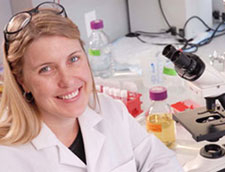
Dr. Matthew Porteus
|
The headline in The Huffington Post heralded this new amfAR-funded work by stating that, “HIV-resistant cells created by Stanford researchers could protect patients from AIDS.” An ABC News blog further declared that, “Genetically modified cells could prevent death from HIV/AIDS, study finds.” And what led to all this promise and excitement? amfAR grantees Dr. Matthew Porteus, working in the Department of Pediatrics at Stanford University, and Sara Sawyer at the University of Texas, have worked with colleagues to create, in the test tube, genetically modified human T cells resistant to HIV infection.
Porteus, Sawyer and colleagues took a lead from prior amfAR-funded research into so-called “restriction factors,” or normal cellular genes that have the capacity to limit the growth of HIV. Utilizing a novel and complex gene strategy based on enzymes that can cut into a host’s DNA, they were able to insert such factors—including APOBEC3G and TRIM5α—into a host gene, CCR5, disrupting that gene in the process. CCR5 normally codes for a critical receptor, or door, by which most strains of HIV enter a cell.

Dr. Sara Sawyer |
They refer to this approach as “Genetic HAART,” as it uses a “cocktail,” not of drugs as we normally associate with HAART (highly active antiretroviral therapy), but of genes. But both approaches involve agents with overlapping or different mechanisms of action against HIV, making resistance much less of a risk.
As Porteus explained in his paper, published online in late January in Molecular Therapy, a journal of the American Society of Gene and Cell Therapy, “this strategy provides multiple parallel blocks to infection.” Indeed it did. The researchers were able to protect cells against HIV strains which used the CCR5 pathway as well as other HIV strains that used an alternate “door” to infection, CXCR4.
“This method would give people a protected reservoir of T cells that would thwart off immune system collapse, and the secondary infections that give rise to AIDS,” said Dr. Sawyer, in the ABC News blog. This work, though as yet only at the test-tube stage, is an important step toward an eventual practical cure for AIDS.
Dr. Laurence is amfAR’s senior scientific consultant.
Related Articles
Man (and Woman) Versus Virus
Fighting HIV with Genetics